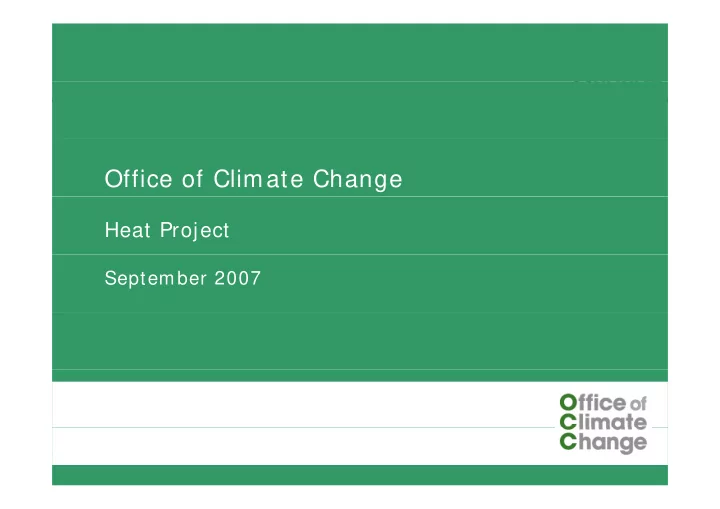

Office of Climate Change Heat Project September 2007 1
The project aims to develop options to decarbonise heat without significantly worsening fuel poverty heat without significantly worsening fuel poverty • The OCC Heat Project has been running since January and has four main objectives To provide an overview of the ‘heat and cooling sector’ To provide an overview of the heat and cooling sector – Establish the carbon impact of heat generation (and cooling) and assess the potential – for this to be reduced Identify and assess alternative or additional policy mechanisms Identify and assess alternative or additional policy mechanisms – Make recommendations on the optimum set of mechanisms and next steps – • We submitted a 2nd interim report to Ministers in July setting out the scale of opportunity and the barriers we face in decarbonising heat. This has been based on: analysis by sector of emissions, reviews of existing practice within and outside of the UK, and interviews with leading industry experts. • We sre currently working up options to decarbonise heat while maintaining a secure energy supply to report in the next month. In doing so, we will work within existing UK competitive markets and, in particular, will ensure that any impact on fuel poverty is minimal or options to offset it are worked up if this is large. 2
The way we generate heat and cooling accounts for nearly half of UK CO emissions nearly half of UK CO 2 emissions • There are a number of ways we y generate and use heating/ cooling. CO 2 emissions by energy source* These make up the heat sector and (broadly) are: Heating space (e.g. our homes and – places of work) Heating water (e.g. for personal Heating water (e.g. for personal – use) Industrial processes (e.g. steel – manufacturing) manufacturing) • Overall, emissions from heating and cooling account for 49% of our energy li t f 49% f use and around 47% of UK emissions (see left) * BERR Energy Trends July 2007 3
The Stern report identified three main issues: these define our workstreams define our workstreams Three main issues identified by Stern: y Creating a single carbon price for heat: We will examine the merits of introducing a single carbon price for Lack of a ‘carbon price’ heat and of allowing, carbon trading between heat and other to reflect the wider economic sectors: damage emissions cause − Workstream 1: Carbon markets Addressing other barriers to new/ existing technologies: Barriers to These workstreams address the wider barriers to the main new and technological rollout existing technologies in heat. These are: existing technologies in heat. These are: − Workstream 2: Renewable heat − Workstream 3: Community heat y Wider barriers to − Workstream 4: Large scale heat change (e.g. consumer behaviour) 4
Decarbonised heat could make a significant contribution to reducing UK CO 2 emissions by 2020 contribution to reducing UK CO emissions by 2020 Potential reductions to annual CO2 emissions realisable through the use of heat technologies 300 The EWP is expected to save 21 MtCO2 Market Potential (medium over Business As Usual predictions by 2020 confidence): This is the (8.7% saving) saving that could be possible if existing policies 250 8.34 Mt CO2 3.44% 0.065% 3.87% are used effectively and 1.52 Mt CO2 8.98 Mt CO2 8.98 Mt CO2 regulatory barriers are regulatory barriers are removed. 27 Mt CO2 ns (MtCO2) 11% 25 Mt CO2 200 11.6% Technical Potential (low Technical Potential (low Dioxide emissio confidence): This is the 48 Mt CO2 25% saving that is physically 150 possible for this technology 242 Mt CO2 Carbon D 216 Mt CO2 100 191 Mt CO2 143 Mt CO2 CO2 emissions remaining if all technical potentials realized. Note that this 50 figure does not incorporate overlap between figures. 0 Total emissions 2020 BAU Industrial CHP Community Heating Renewable Heat * This chart is intended to indicate the relative size of the savings available, and does not imply that technologies should be deployed in the order 5 shown
Executive summary: we will carry out further work over the summer – focussing on developing options the summer focussing on developing options Workstreams: Further work: • Work up options for introducing carbon trading for the whole of the UK heat sector and set out their implications including their fit with wider objectives/ policies Carbon markets • Work up options to put renewable heat on a more equal footing with renewable electricity and transport, and examine how regulatory and other barriers can be y p , g y Renewable heat Renewable heat tackled to increase the amount of heat from waste and biomass. • Explore ways that local government can coordinate district heating networks where Explore ways that local government can coordinate district heating networks where Community they can deliver a benefit, and the capital can be mobilised to develop them. Heat • Work up options for encouraging co-location of large-scale heat suppliers and potential customers to reduce customer risk; conduct further analysis of industrial Large scale heat waste heat opportunities and make recommendations for incentivisation of CHP . 6
Recommend
More recommend